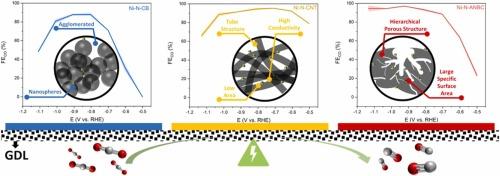当前位置:
X-MOL 学术
›
Nano Energy
›
论文详情
Our official English website, www.x-mol.net, welcomes your
feedback! (Note: you will need to create a separate account there.)
The effect of carbon supports on the electrocatalytic performance of Ni-N-C catalysts for CO2 reduction to CO
Nano Energy ( IF 16.8 ) Pub Date : 2024-11-08 , DOI: 10.1016/j.nanoen.2024.110461 Shilong Fu, Boaz Izelaar, Ming Li, Qi An, Min Li, Wiebren de Jong, Ruud Kortlever
Nano Energy ( IF 16.8 ) Pub Date : 2024-11-08 , DOI: 10.1016/j.nanoen.2024.110461 Shilong Fu, Boaz Izelaar, Ming Li, Qi An, Min Li, Wiebren de Jong, Ruud Kortlever

|
Carbon-supported nickel and nitrogen co-doped (Ni-N-C) catalysts have been extensively studied as selective and active catalysts for CO2 electroreduction to CO. Most studies have focused on adjusting the coordination structure of Ni-Nx active sites, while the impact of the carbon supports has often been overlooked. In this study, a series of Ni-N-C catalysts on different carbon supports, including carbon black (CB), multi-walled carbon nanotubes (CNT), and activated nitrogen-doped biochar (ANBC), were synthesized using a ligand-mediated method. The effect of the carbon support on the electrocatalytic performance for CO2 reduction was investigated at both low current densities, in a H-cell, and high current densities, in a MEA electrolyzer. All of the prepared Ni-N-C catalysts show good faradaic efficiencies (FE) toward CO production (up to ∼90 %), however, the onset potentials and partial current densities for CO production vary greatly. The textural properties of the carbon support and the distribution of Ni-Nx active sites on the carbon support are demonstrated as the main factors behind the performance differences. In particular, hierarchical porous structures with a large specific surface area are helpful to facilitate mass transport and improve the dispersion of active sites, which allows for a better CO2 reduction performance of Ni-N-ANBC compared to Ni-N-CB and Ni-N-CNT. This study demonstrates the importance of the carbon support for Ni-N-C catalysts and provides new insights into the design of efficient Ni-N-C catalysts for the CO2 RR.
中文翻译:

碳载体对 Ni-N-C 催化剂将 CO2 还原为 CO 的电催化性能的影响
碳负载镍和氮共掺杂 (Ni-N-C) 催化剂作为 CO2 电还原为 CO 的选择性和活性催化剂已被广泛研究。大多数研究都集中在调整 Ni-Nx 活性位点的配位结构上,而碳载体的影响往往被忽视。在本研究中,采用配体介导的方法合成了一系列基于不同碳载体的 Ni-N-C 催化剂,包括炭黑 (CB)、多壁碳纳米管 (CNT) 和活性氮掺杂生物炭 (ANBC)。在 H 电池中的低电流密度和 MEA 电解槽中的高电流密度下研究了碳载体对 CO2 还原电催化性能的影响。所有制备的 Ni-N-C 催化剂对 CO 生产都显示出良好的法拉第效率 (FE)(高达 ∼90 %),但是,用于 CO 生产的起始电位和部分电流密度差异很大。碳载体的织构特性和 Ni-Nx 活性位点在碳载体上的分布被证明是性能差异的主要因素。特别是,具有大比表面积的多级多孔结构有助于促进质量传递和改善活性位点的分散,这使得 Ni-N-ANBC 与 Ni-N-CB 和 Ni-N-CNT 相比具有更好的 CO2 还原性能。本研究证明了碳载体对 Ni-N-C 催化剂的重要性,并为设计用于 CO2RR 的高效 Ni-N-C 催化剂提供了新的见解。
更新日期:2024-11-08
中文翻译:

碳载体对 Ni-N-C 催化剂将 CO2 还原为 CO 的电催化性能的影响
碳负载镍和氮共掺杂 (Ni-N-C) 催化剂作为 CO2 电还原为 CO 的选择性和活性催化剂已被广泛研究。大多数研究都集中在调整 Ni-Nx 活性位点的配位结构上,而碳载体的影响往往被忽视。在本研究中,采用配体介导的方法合成了一系列基于不同碳载体的 Ni-N-C 催化剂,包括炭黑 (CB)、多壁碳纳米管 (CNT) 和活性氮掺杂生物炭 (ANBC)。在 H 电池中的低电流密度和 MEA 电解槽中的高电流密度下研究了碳载体对 CO2 还原电催化性能的影响。所有制备的 Ni-N-C 催化剂对 CO 生产都显示出良好的法拉第效率 (FE)(高达 ∼90 %),但是,用于 CO 生产的起始电位和部分电流密度差异很大。碳载体的织构特性和 Ni-Nx 活性位点在碳载体上的分布被证明是性能差异的主要因素。特别是,具有大比表面积的多级多孔结构有助于促进质量传递和改善活性位点的分散,这使得 Ni-N-ANBC 与 Ni-N-CB 和 Ni-N-CNT 相比具有更好的 CO2 还原性能。本研究证明了碳载体对 Ni-N-C 催化剂的重要性,并为设计用于 CO2RR 的高效 Ni-N-C 催化剂提供了新的见解。


















































 京公网安备 11010802027423号
京公网安备 11010802027423号